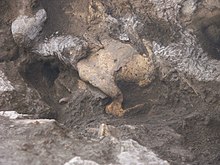Dmanisi skull
 |
|
| Catalog no. | D4500 |
|---|---|
| Common name | Dmanisi skull 5 |
| Species | Homo erectus |
| Age | 1.8 million years |
| Place discovered | Dmanisi in Georgia |
| Date discovered | 2005 |
| Discovered by | David Lordkipanidze |
The Dmanisi skull, also known as Skull 5 or D4500, is one of five Homo erectus skulls discovered in Dmanisi, Georgia. Described in a publication in October 2013, it is believed to be about 1.8 million years old and is the most complete skull of a Homo species, and the first complete adult hominin skull of that degree of antiquity. According to researchers, the discovery "provides the first evidence that early Homo comprised adult individuals with small brains but body mass, stature and limb proportions reaching the lower range limit of modern variation."
The skull has been the cause of a paleontological controversy that is still ongoing as of 2017: many hominin fossils thought to be from different species such as Homo rudolfensis or Homo habilis may not have been separate species at all. Rather, they may have been a single evolving lineage.
In 1991, Georgian scientist David Lordkipanidze found traces of early human occupation in the cave at Dmanisi in Georgia: a hamlet and an archaeological site about 90 kilometres (56 mi) southwest of the country's capital, Tbilisi. Since then, five early hominin skulls have been discovered at the site. Skull 5, found in 2005, is the most complete specimen of them all. After further analysis, it was coupled with its mandible (D2600) found 5 years earlier. The final analysis of the discovery took many years and was only published in 2013.
Despite a brain volume the size of a large Australopithecus male, (546 cubic centimetres (33.3 in3)) all the characteristics of Homo erectus are clearly visible on Skull 5. The braincase sizes of the other Dmanisi skulls are between 601 cubic centimetres (36.7 in3) and 730 cubic centimetres (45 in3).
...
Wikipedia
